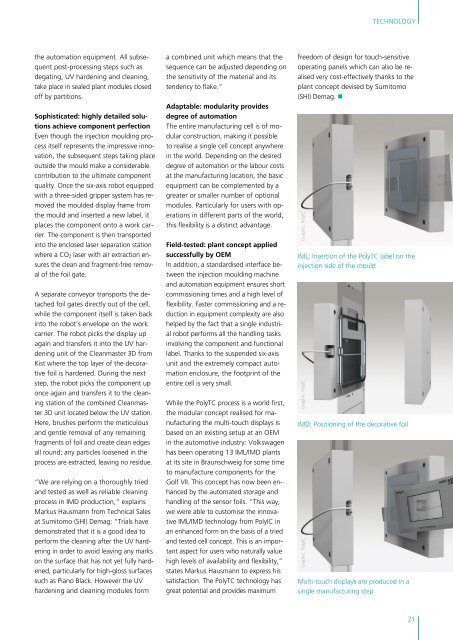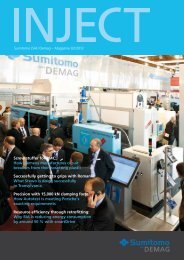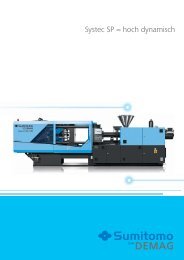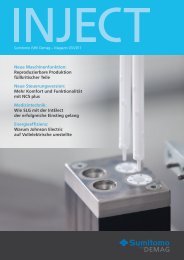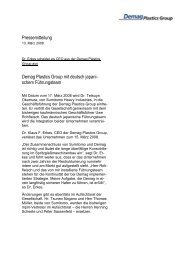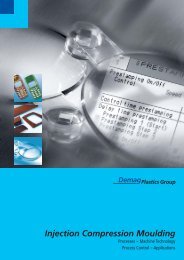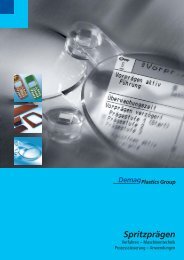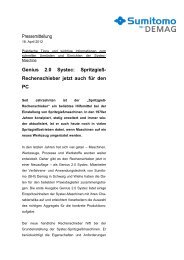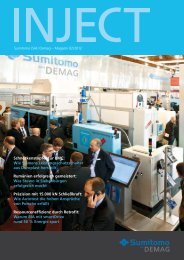4690_Inject_1_2013_en_130710.pdfDownload - Sumitomo (SHI ...
4690_Inject_1_2013_en_130710.pdfDownload - Sumitomo (SHI ...
4690_Inject_1_2013_en_130710.pdfDownload - Sumitomo (SHI ...
You also want an ePaper? Increase the reach of your titles
YUMPU automatically turns print PDFs into web optimized ePapers that Google loves.
TECHNOLOGY<br />
the automation equipm<strong>en</strong>t. All subsequ<strong>en</strong>t<br />
post-processing steps such as<br />
degating, UV hard<strong>en</strong>ing and cleaning,<br />
take place in sealed plant modules closed<br />
off by partitions.<br />
Sophisticated: highly detailed solutions<br />
achieve compon<strong>en</strong>t perfection<br />
Ev<strong>en</strong> though the injection moulding process<br />
itself repres<strong>en</strong>ts the impressive innovation,<br />
the subsequ<strong>en</strong>t steps taking place<br />
outside the mould make a considerable<br />
contribution to the ultimate compon<strong>en</strong>t<br />
quality. Once the six-axis robot equipped<br />
with a three-sided gripper system has removed<br />
the moulded display frame from<br />
the mould and inserted a new label, it<br />
places the compon<strong>en</strong>t onto a work carrier.<br />
The compon<strong>en</strong>t is th<strong>en</strong> transported<br />
into the <strong>en</strong>closed laser separation station<br />
where a CO 2 laser with air extraction <strong>en</strong>sures<br />
the clean and fragm<strong>en</strong>t-free removal<br />
of the foil gate.<br />
A separate conveyor transports the detached<br />
foil gates directly out of the cell,<br />
while the compon<strong>en</strong>t itself is tak<strong>en</strong> back<br />
into the robot’s <strong>en</strong>velope on the work<br />
carrier. The robot picks the display up<br />
again and transfers it into the UV hard<strong>en</strong>ing<br />
unit of the Cleanmaster 3D from<br />
Kist where the top layer of the decorative<br />
foil is hard<strong>en</strong>ed. During the next<br />
step, the robot picks the compon<strong>en</strong>t up<br />
once again and transfers it to the cleaning<br />
station of the combined Cleanmaster<br />
3D unit located below the UV station.<br />
Here, brushes perform the meticulous<br />
and g<strong>en</strong>tle removal of any remaining<br />
fragm<strong>en</strong>ts of foil and create clean edges<br />
all round; any particles loos<strong>en</strong>ed in the<br />
process are extracted, leaving no residue.<br />
“We are relying on a thoroughly tried<br />
and tested as well as reliable cleaning<br />
process in IMD production,” explains<br />
Markus Hausmann from Technical Sales<br />
at <strong>Sumitomo</strong> (<strong>SHI</strong>) Demag: “Trials have<br />
demonstrated that it is a good idea to<br />
perform the cleaning after the UV hard<strong>en</strong>ing<br />
in order to avoid leaving any marks<br />
on the surface that has not yet fully hard<strong>en</strong>ed,<br />
particularly for high-gloss surfaces<br />
such as Piano Black. However the UV<br />
hard<strong>en</strong>ing and cleaning modules form<br />
a combined unit which means that the<br />
sequ<strong>en</strong>ce can be adjusted dep<strong>en</strong>ding on<br />
the s<strong>en</strong>sitivity of the material and its<br />
t<strong>en</strong>d<strong>en</strong>cy to flake.”<br />
Adaptable: modularity provides<br />
degree of automation<br />
The <strong>en</strong>tire manufacturing cell is of modular<br />
construction, making it possible<br />
to realise a single cell concept anywhere<br />
in the world. Dep<strong>en</strong>ding on the desired<br />
degree of automation or the labour costs<br />
at the manufacturing location, the basic<br />
equipm<strong>en</strong>t can be complem<strong>en</strong>ted by a<br />
greater or smaller number of optional<br />
modules. Particularly for users with operations<br />
in differ<strong>en</strong>t parts of the world,<br />
this flexibility is a distinct advantage.<br />
Field-tested: plant concept applied<br />
successfully by OEM<br />
In addition, a standardised interface betwe<strong>en</strong><br />
the injection moulding machine<br />
and automation equipm<strong>en</strong>t <strong>en</strong>sures short<br />
commissioning times and a high level of<br />
flexibility. Faster commissioning and a reduction<br />
in equipm<strong>en</strong>t complexity are also<br />
helped by the fact that a single industrial<br />
robot performs all the handling tasks<br />
involving the compon<strong>en</strong>t and functional<br />
label. Thanks to the susp<strong>en</strong>ded six-axis<br />
unit and the extremely compact automation<br />
<strong>en</strong>closure, the footprint of the<br />
<strong>en</strong>tire cell is very small.<br />
While the PolyTC process is a world first,<br />
the modular concept realised for manufacturing<br />
the multi-touch displays is<br />
based on an existing setup at an OEM<br />
in the automotive industry: Volkswag<strong>en</strong><br />
has be<strong>en</strong> operating 13 IML/IMD plants<br />
at its site in Braunschweig for some time<br />
to manufacture compon<strong>en</strong>ts for the<br />
Golf VII. This concept has now be<strong>en</strong> <strong>en</strong>hanced<br />
by the automated storage and<br />
handling of the s<strong>en</strong>sor foils. “This way,<br />
we were able to customise the innovative<br />
IML/IMD technology from PolyIC in<br />
an <strong>en</strong>hanced form on the basis of a tried<br />
and tested cell concept. This is an important<br />
aspect for users who naturally value<br />
high levels of availability and flexibility,”<br />
states Markus Hausmann to express his<br />
satisfaction. The PolyTC technology has<br />
great pot<strong>en</strong>tial and provides maximum<br />
freedom of design for touch-s<strong>en</strong>sitive<br />
operating panels which can also be realised<br />
very cost-effectively thanks to the<br />
plant concept devised by <strong>Sumitomo</strong><br />
(<strong>SHI</strong>) Demag. •<br />
Graphic: PolylC Graphic: PolylC<br />
IML: Insertion of the PolyTC label on the<br />
injection side of the mould<br />
IMD: Positioning of the decorative foil<br />
Graphic: PolylC<br />
Multi-touch displays are produced in a<br />
single manufacturing step<br />
21


